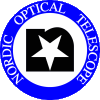Overview of
the NOT Educational Programmes In the era of
8m telescopes, it makes good sense to use part of the time on a
2m-class telescope as a tool to attract and train the next
generation of observational astronomers. The NOT is particularly
well placed to fill this need: First, it can serve all five Nordic
countries, with a combined population of ~25 million and with
astronomical communities that are very diverse and individually
too small to maintain research-class telescopes for educational
purposes. Second, NOT is designed for ease of access and
simplicity of operation for the observer, and students can observe
on their own after just a couple of hours of instruction. Third,
our family-style group has proved to be a fertile environment for
students to spend a period of hands-on training at an
international observatory. We have used these strengths to design
a coherent set of educational services that can be offered to
students ranging from the undergraduate to the PhD level.
A general overview of the Educational use of the
NOT in the form of student training is provided here, and is briefly described below. A
detailed description of what is offered to groups that want to use
the NOT for an observational course, including general guidelines
which describe the various steps in the preparation, is given here.
On-site training courses On-site training courses in observational astronomy
have been held at NOT for several years. In such courses, groups
of up to 12 students spend 1-2 weeks on La Palma, observing with
NOT for typically 6 nights. Because only ~3 students can be
accommodated in the control room at the same time, the sitting
room in our service building is converted into a classroom with a
large projection screen, tables, and network connections (see
above). In this way, instruction in the use of the telescope - or
in any other subject - can be given to the entire group at once,
and the students who are not actually at the controls can follow
the observations as if they were watching in the control room
itself. During and after the observations, the students can reduce
the data already obtained with help from the teachers; we provide
a set of powerful laptop computers with all the required software
packages pre-installed and tested for this purpose. Often,
students choose their observing projects before the course by
filling out proposal forms as if they were actually applying for
observing time, and prepare their final reports as a professional
research paper for one of the main journals - some of which are in
fact published. See below for links to some
recent Nordic and national schools of this type, which are
typically aimed at students at the PhD level.
Remote observing for off-site
courses On-site courses are very
popular with the students because of the hands-on experience and
the excitement of travelling to the Canary Islands. They do,
however, come at a significant price in terms of travel cost and
time for both students and teachers, and our capacity is
limited. Using the capabilities of our new Telescope Control
System, we therefore now also offer a remote observing option for
off-site courses. This may be motivated by a wish to use NOT in
parallel with other telescopes, such as the Molétai
Observatory in Lithuania, or our optical/NIR/mm radio training
courses at Tuorla
Observatory, Finland in June 2009, and at Onsala
Space Observatory, Sweden in June 2010 supported by NORDFORSK. Alternatively, the
number of students in a class may exceed our capacity, or the
amount of observing time needed may be insufficient to warrant a
group trip to the Canary Islands. In such cases, a classroom of
any size, and in principle anywhere in the world, can be set up as
a remote observing room, provided it has proper network
connections and projection equipment. The layout is similar to
that shown above, but students will actually be at the keyboard
and conduct their observations themselves under the supervision of
an on-site staff member. In this way, students may perform a few
hours of observation without interrupting their regular studies,
also at the undergraduate level, and a backup night can be
provided in case of poor weather. These options are also described
in the paper Educational use of
NOT.
Research studentships at
NOT As a final step in their
education, a few students are offered the opportunity to spend a
period of the order of a year with the NOT group on La Palma
during their PhD studies or in the final year of their MSc. The
group of ~5 NOT Research Students are fully integrated in our team
and divide their time between their thesis project and practical
work at the telescope, such as further development of ourservices
or support to visiting astronomers. The hands-on experience with
advanced instrumentation and added maturity gained by the students
in an international setting have proved to be an important asset
in the future careers, not only in astronomy or related sciences
(over 80% of them), but also outside astronomy. See the
description of life as a NOT student by one of them on p. 26 of
our Annual
Report 2007 and the links below for further information.
|

